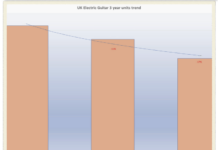How the Beatles’ “Day Tripper” Guitar Riff Blurs the Line Between Major and Minor
“Day Tripper” is among the surprisingly few riff rockers in the Beatles’ prodigious catalog.
The song was written in 1965 and issued as a single to coincide with Rubber Soul, the group’s sixth album, which was released in December of that year.
“Day Tripper” was a rush job. In October, as the Beatles were in the midst of completing Rubber Soul, they were told they still needed to come up with a single to accompany the album’s release. John Lennon and Paul McCartney quickly got to work on a new composition and came up with “Day Tripper,” a reworking of a blues tune Lennon had written about a month earlier.
The song is among the few Beatles originals built around the 12-bar blues format, which they altered to suit their harmonic requirements. Lennon and McCartney explained that the song is in reference to people who have a casual interest in drugs—“weekend hippies,” as Lennon put it. But as the lyrics refer to a girl, the subject could be extended to sex, as the line “she’s a big teaser, she took me half the way there” suggests. The song was recorded on October 16, 1965, and released as a single, backed with “We Can Work It Out,” in early December.
In this video, Sean Daniel deconstructs the main riff to “Day Tripper” to reveal how it incorporates elements of the minor scale into a major chord. He demonstrates how to play the part and then breaks down the theory behind it.
Sean’s previous Riff Deconstructions include John Frusciante’s guitar motif in the Red Hot Chili Peppers’ “Scar Tissue,” Brian Jones’ marimba part in the Rolling Stones’ “Under My Thumb,” Jimmy Page’s “Kashmir” riff and Jimi Hendrix’s main guitar part to “Manic Depression. These exercises are a great way to not only learn these parts but also get an understanding of their underlying structure and theory.
For more of Sean’s videos, visit his YouTube channel.
Source: www.guitarworld.com











